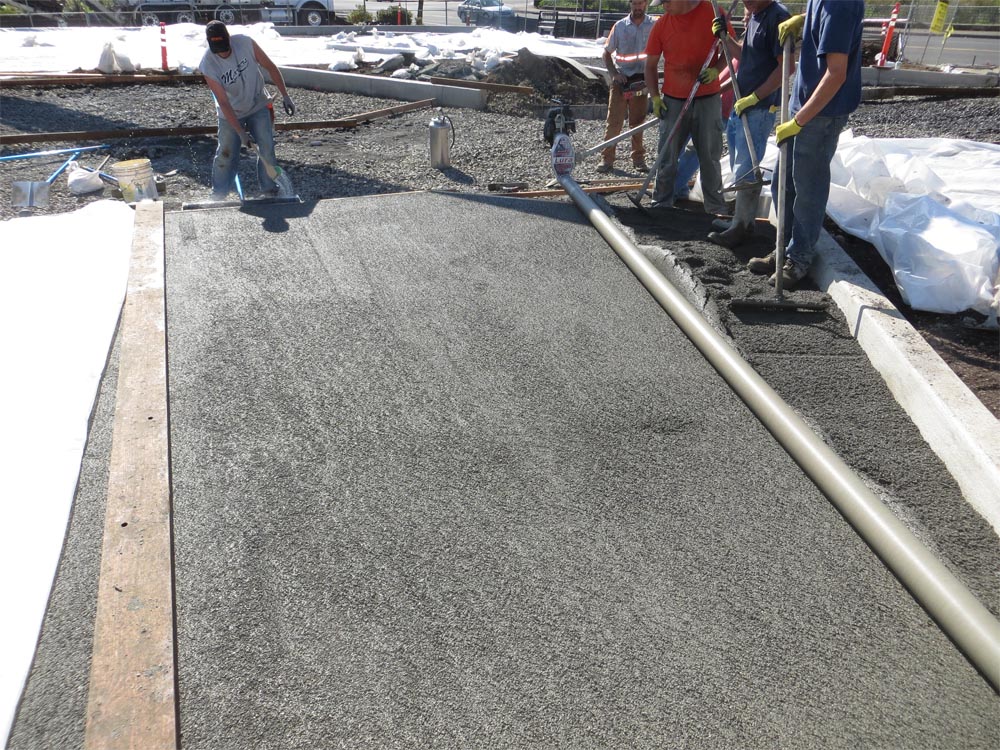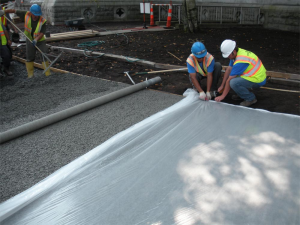There are many different types of pavements available today. With the world moving toward an eco-friendly society, pavement contractors have gotten on board too and create several options for an economically friendly pavement option.
One such option, that is one of the more popular, is pervious concrete. Pervious is a concrete pavement with no sand in it, which allows water to flow through it freely. Due to the lack of sand and void space in the rock layer, water can pass through the pavement into the soil. This keeps water from needing to be channeled in rivers or streams damaging the environment from the harsh chemical. The pavement acts as a retention area and creates a filtration process as the water passes through it removing harmful pollutants and chemicals creating clear water being stored in the soil.
Like other pavements it starts with a rock layer under the concrete, but there are extra things to consider with the rock layer to pervious concrete. Since most rock would contain dust or sand this can affect the pervious mix resulting in a bad pour. Therefore, the cleanliness of the rock and the void space between the rock must be calculated to determine if modification is needed to mix for a successful pour.

One of Lura Enterprises’ dealers is Scott Erickson at Evolution Pervious Resource.
Evolution Pervious is the national leader in Architectural fine-grain pervious concrete pavements. Scott has been in the business for many years and trains others how to pour pervious concrete. Scott shared some of his year of insight on the subject.
“Pervious concrete is easy, but it is different. It needs to be placed, compacted, and edged and covered with sheet plastic within 10 minutes of placement. The moisture content of the pervious mix is critically important. The cement must be hydrated with enough water to activate the powdered cement. Too dry is very difficult to work with and results in weak, unattractive pavements. Too much water, the paste will be weakened and may drain off the rock. Curing is critical because the cement paste covering the open graded aggregates can dry out faster than it can gain enough strength to work properly.
The most common problem is inexperience with recognizing the right moisture content of the mix. Wet or dry mixes can make or break you. Proper preparation for placing pervious within the short working time is another big issue. Having enough people, having the right tools and having curing plastic ready is very important. Over complicating placements is another issue. Access for the truck to reach the forms is important. You only get one chute, pervious does not flow down long chutes. If access is limited, you must find a way to transport the mix to the forms. Conveyer, buggy, wheelbarrow, front end loader, excavator. These all have worked, but you must have them onsite ready to go for them to work.”
The National Ready Mixed Concrete Association (NRMCA) provides
training on pervious concrete for those that want to pour it. While training is not required, it is highly recommended as it teaches you what you must do and how to do it. Scott is also a certified trainer and private companies like Evolution Pervious Resources offer these classes and field training wherever you are. The program has several levels:
I. Technician level is classroom training with a test. My classes require hands on training with a live demo. Not all Technician classes require that.
II. Installer level allows Technicians to demonstrate they know how to recognize and correct the mix to water consistency, site preparation, placement time and curing requirements. Installers must provide written proof of 3 jobs, 10,000 sf of pervious work and pass a field proficiency test administered by a Craftsman to qualify.
III. Certified Craftsmen must have Installer certificate plus 1500 documented hours of work in the field with pervious concrete. They should know pervious mix designs, moisture control, site prep and proper installation tools and techniques and must be capable and willing to stop a job when anything with the pervious installation gets out of specification during the job.
Due to the environmentally friendly nature of pervious concrete, it can help a those seeking to become LEED certified. LEED stands for leadership in Energy and Environmental Design. This is a widely used green building rating system throughout the entire world, available for almost any building type. With a LEED certification investor can better meet their ESG goals by providing a globally recognized green building framework. To learn more about LEED certification you can
visit their website.
.jpg)

.jpg)